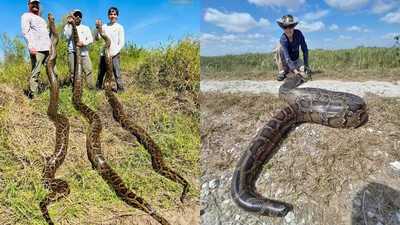“ Florida Man saves the planet by turning pythons into handbags” sounds like the setup to a meme — and in true Florida fashion, it’s also a real policy. The state that brought us alligators in drive-thrus and hurricane parties has found a novel way to deal with one of its most destructive environmental threats: turning invasive Burmese pythons into high-end fashion.
Governor Ron DeSantis this week highlighted a state-backed effort to remove the snakes from the Everglades and convert their skins into luxury accessories. Through a partnership with the Florida Fish and Wildlife Conservation Commission (FWC) and Miami-based textiles manufacturer Inversa , the state aims to curb a predator responsible for devastating local wildlife while supporting a booming market for so-called “ethical exotics.” In this case, shopping is being sold as a form of environmental rescue.
Predator python meets A-list fashion
Burmese pythons have been wiping out native species since they were introduced to Florida through the illegal pet trade in the 1970s. DeSantis warned that the snakes can “take out a deer” and pose a severe threat to endangered wildlife. Inversa claims that repurposing python hides helps protect hundreds of native animals that the predators would otherwise consume.

The company’s model appeals to fashion brands seeking sustainability . Instead of farming or illegal hunting, designers can use skins from invasive species already harming ecosystems.
From the Everglades to the catwalk
The skins do not sit in warehouses. They are already walking the runway. Designers including Gabriela Hearst and KHAITE have incorporated Inversa python leather into jackets, handbags, belts and boots featured in Fall 2025 collections. The pieces are presented as luxury fashion with a purpose, where bold patterns and sleek textures come with a story of ecological restoration.

Luxury pieces such as python-inlaid cuffs and high-end belts now retail for more than $1,000 each, appealing to shoppers who want products with a unique origin story. Fashion critics say the trend allows consumers to wear something striking while supporting a conservation effort that could help save dozens of threatened animal species.
Hearst has praised the initiative as a “game-changer,” highlighting its alignment with her long-standing commitment to sustainability and responsible sourcing. She has used Florida python leather in tailored outerwear, structured tote bags and statement boots that are now popular with environmentally conscious celebrities.
A partnership that is paying off
According to the governor’s office, Florida’s collaboration with Inversa has significantly increased python removals. Between May and July 2025, 1,022 snakes were captured, nearly triple the number caught during the same period in 2024.

DeSantis said the programme now removes more pythons in a single month than were captured across the entire previous year. By working directly with about 50 professional hunters formerly contracted by the state, Inversa has also boosted pay rates by around 60 percent while reducing administrative burden by almost 90 percent for FWC.
A win for conservation and wardrobes
State officials argue that linking conservation to designer fashion has simplified one of Florida’s most expensive ecological battles. By shifting costs to the fashion sector, taxpayers are no longer solely responsible for Everglades python removal.
FWC Chairman Rodney Barreto said the partnership demonstrates “milestones we have achieved against the invasive Burmese python , which will benefit generations to come.” Even DeSantis, more commonly associated with culture-war politics than couture, conceded with a smile: “I will tell you some of the stuff is very fashionable.”
Governor Ron DeSantis this week highlighted a state-backed effort to remove the snakes from the Everglades and convert their skins into luxury accessories. Through a partnership with the Florida Fish and Wildlife Conservation Commission (FWC) and Miami-based textiles manufacturer Inversa , the state aims to curb a predator responsible for devastating local wildlife while supporting a booming market for so-called “ethical exotics.” In this case, shopping is being sold as a form of environmental rescue.
Predator python meets A-list fashion
Burmese pythons have been wiping out native species since they were introduced to Florida through the illegal pet trade in the 1970s. DeSantis warned that the snakes can “take out a deer” and pose a severe threat to endangered wildlife. Inversa claims that repurposing python hides helps protect hundreds of native animals that the predators would otherwise consume.
The company’s model appeals to fashion brands seeking sustainability . Instead of farming or illegal hunting, designers can use skins from invasive species already harming ecosystems.
From the Everglades to the catwalk
The skins do not sit in warehouses. They are already walking the runway. Designers including Gabriela Hearst and KHAITE have incorporated Inversa python leather into jackets, handbags, belts and boots featured in Fall 2025 collections. The pieces are presented as luxury fashion with a purpose, where bold patterns and sleek textures come with a story of ecological restoration.

Luxury pieces such as python-inlaid cuffs and high-end belts now retail for more than $1,000 each, appealing to shoppers who want products with a unique origin story. Fashion critics say the trend allows consumers to wear something striking while supporting a conservation effort that could help save dozens of threatened animal species.
Hearst has praised the initiative as a “game-changer,” highlighting its alignment with her long-standing commitment to sustainability and responsible sourcing. She has used Florida python leather in tailored outerwear, structured tote bags and statement boots that are now popular with environmentally conscious celebrities.
A partnership that is paying off
According to the governor’s office, Florida’s collaboration with Inversa has significantly increased python removals. Between May and July 2025, 1,022 snakes were captured, nearly triple the number caught during the same period in 2024.
DeSantis said the programme now removes more pythons in a single month than were captured across the entire previous year. By working directly with about 50 professional hunters formerly contracted by the state, Inversa has also boosted pay rates by around 60 percent while reducing administrative burden by almost 90 percent for FWC.
A win for conservation and wardrobes
State officials argue that linking conservation to designer fashion has simplified one of Florida’s most expensive ecological battles. By shifting costs to the fashion sector, taxpayers are no longer solely responsible for Everglades python removal.
FWC Chairman Rodney Barreto said the partnership demonstrates “milestones we have achieved against the invasive Burmese python , which will benefit generations to come.” Even DeSantis, more commonly associated with culture-war politics than couture, conceded with a smile: “I will tell you some of the stuff is very fashionable.”
You may also like

Rohit Sharma Praises Key Partnership with Virat Kohli in ODI Victory

'Laid down arms in line with Basavaraj's call': Maoist Rupesh rejects 'traitor' tag; explains reason for surrender

Uttarakhand announces implementation of Green Cess on vehicles from other states on its 25th anniversary

Putin puppet makes chilling 'nuclear weapons' suggestion in rage over Trump sanctions

Chemistry Nobel Prize winner Susumu Kitagawa reveals Japanese research mindset: 'Don't switch off the light, even…'






